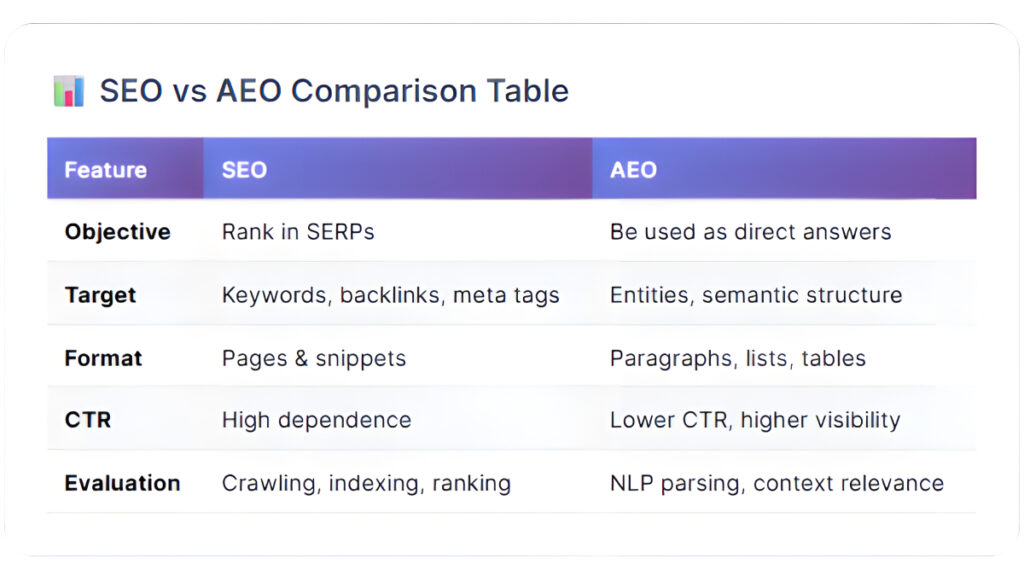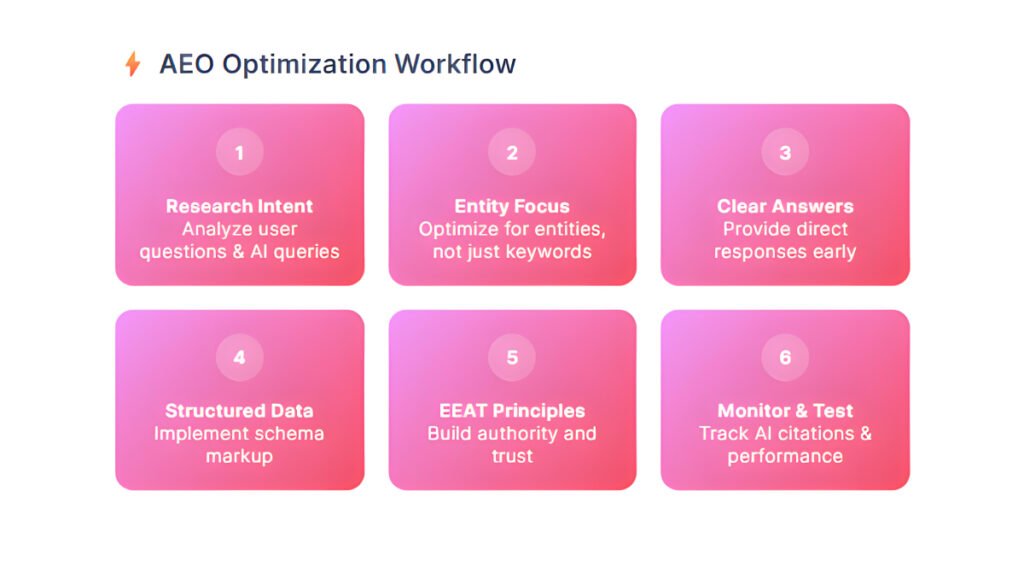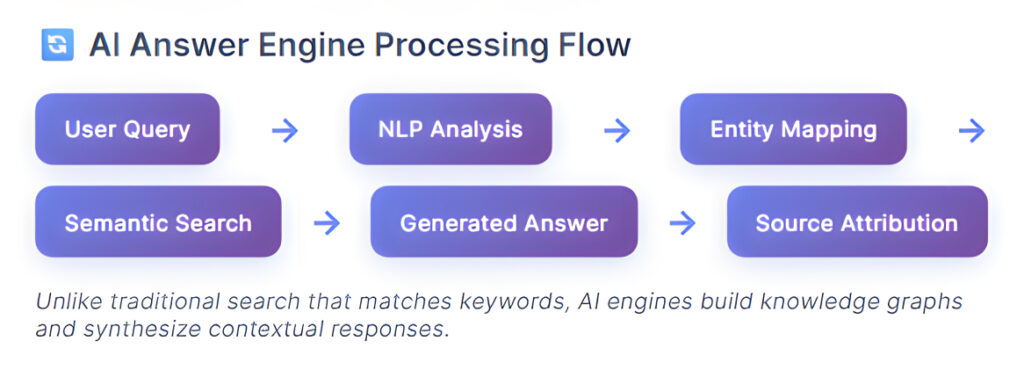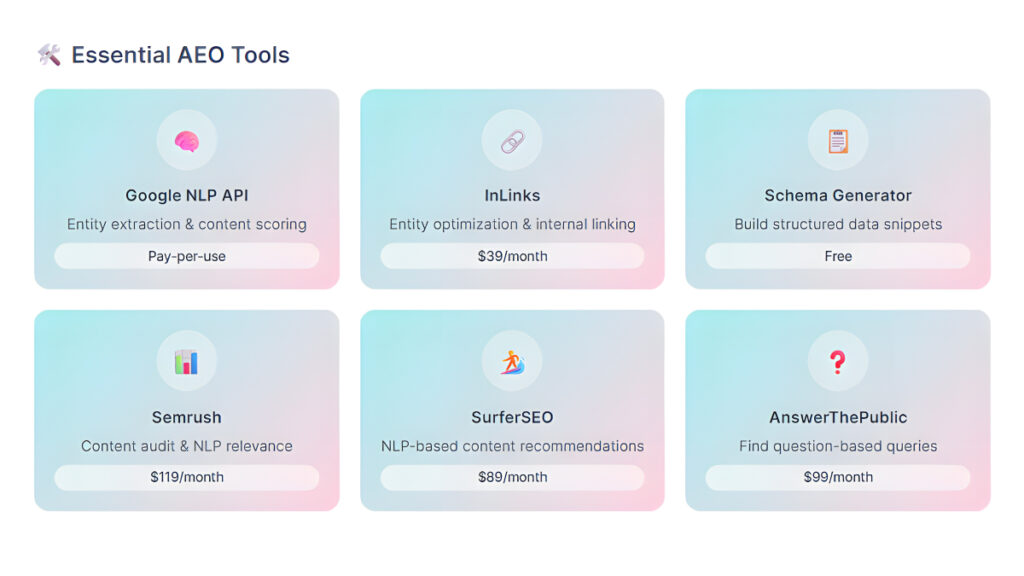TL;DR: Search is changing. AI-powered answer engines like ChatGPT, Perplexity, and Google’s SGE are shifting user behavior away from traditional keyword-based search. Answer Engine Optimization (AEO) helps you stay visible in this new landscape. Let’s dive deep.
What is Answer Engine Optimization (AEO)?
Answer Engine Optimization (AEO) is the practice of tailoring your digital content to be easily understood and directly referenced by AI-powered search engines such as ChatGPT, Google’s Search Generative Experience (SGE), Bing Copilot, and other emerging large language model (LLM) interfaces.
Unlike traditional SEO that targets ranking on results pages, AEO is focused on helping your content appear as a trusted, AI-cited source when these engines generate summarized responses.
Why it matters: AI search models are becoming the norm. Users are shifting from browsing ten blue links to expecting immediate, synthesized answers. If your content is not optimized for AI interpretation, you risk becoming invisible in this new era of search.
Real-World Example: Consider NerdWallet, a personal finance platform that experienced a 20% decline in organic traffic following the rise of AI-generated search summaries.
Rather than panic, they embraced AEO strategies implementing structured data, publishing research-backed financial explainers, and refining their internal linking architecture. As a result, they secured frequent citations in Google’s AI Overviews and ChatGPT answers.
Despite the drop in traffic, their revenue grew by more than 35% in 2024, showing that presence in AI-generated content can deliver measurable business results even when clicks diminish.
How AEO Differs from Traditional SEO
| Feature | Traditional SEO | Answer Engine Optimization (AEO) |
|---|---|---|
| Goal | Rank in top 10 Google links | Get cited as a direct AI-generated answer |
| Content Format | Long-form, keyword-rich pages | Concise, structured, fact-based information |
| User Journey | Clicks to your site | Gets the answer without clicking |
| Optimization Focus | Keywords, backlinks, technical SEO | NLP clarity, schema markup, entity recognition |
Key Takeaways:
- SEO aims for visibility in SERPs.
- AEO aims for citation in zero-click AI responses.
- AEO isn’t a replacement for SEO, it’s an evolution.
Wanna become an AEO Specialist? Consider Reading This: How to Become an AEO Specialist
Why AEO is the Future of Search

1. The Evolution of Search Engines into Answer Engines
Search behavior is rapidly evolving. Users expect answers, not links. Google SGE and ChatGPT have shifted from directing users to websites to delivering summarized, citation-rich answers pulled from trusted sources.
This paradigm shift is reflected in product updates from every major search player:
- Google: AI Overviews, SGE, and BARD
- Microsoft: Bing with Copilot integration
- OpenAI: ChatGPT with browsing capabilities and plugins
- Perplexity AI: A search-engine replacement using LLM summaries with live citations
If your content isn’t structured for direct understanding by these AI systems, it won’t be part of the answer.
2. Rise of Zero-Click and AI-Driven Journeys
A growing body of research suggests that more than 60% of search queries now result in zero clicks. This means users get their answers directly from the SERP or AI engine without needing to visit any external websites. A striking example of this behavior shift can be seen in the decline of traffic to answer-focused platforms like Stack Overflow.
After the launch of ChatGPT, Stack Overflow reported a 14% drop in traffic in March 2023 and another 18% in April 2023. These declines show that users are increasingly finding sufficient information within AI-generated summaries and skipping traditional sites altogether.
This trend has driven businesses to adapt. One SaaS company, after noticing a drop in organic traffic from Google, invested in AEO techniques like structured data, unique content formats, and multi-engine visibility.
Within four months, their brand started appearing in both Perplexity AI and Bing Copilot responses, leading to a 22% increase in brand mentions and a measurable uptick in referral inquiries from users who had seen them featured in AI-generated answers.
In zero-click environments, the most valuable real estate is not the #1 Google result but the body of the AI-generated answer. That’s where AEO shines. A growing body of research suggests that more than 60% of search queries now result in zero clicks.
This means users get their answers directly from the SERP or AI engine without needing to visit any external websites. In zero-click environments, the most valuable real estate is not the #1 Google result but the body of the AI-generated answer. That’s where AEO shines.
3. The Growing Role of AI Gatekeepers
AI interfaces are becoming the new front doors to the internet. Whether it’s Copilot answering a user’s product question or ChatGPT suggesting a how-to, these models act as intermediaries. Optimizing content to appear within their responses is no longer a bonus it’s a necessity.
Want to know if your site is AEO-ready? Run a free audit and discover optimization gaps.
Core Principles of Answer Engine Optimization
1. NLP-Friendly, Clear Writing
AI engines analyze syntax, semantics, and structure through natural language processing. To ensure your content is picked up:
- Use simple sentence constructions.
- Start paragraphs with clear topic sentences.
- Avoid metaphor-heavy or ambiguous phrasing.
- Prioritize clarity over cleverness.
Each section should answer a single question completely. Think of each heading block as a standalone, self-contained unit of value.
2. Implement Structured Data (Schema Markup)
Structured data enhances content comprehension. By marking up your content with Schema.org tags, you help AI understand context, structure, and relationships.
Essential schema types for AEO:
- FAQPage
- HowTo
- Article
- WebPage
- BreadcrumbList
- Organization and Person (for author bios)
Search engines and LLMs trained on structured datasets prioritize this information to extract featured answers.
3. Emphasize Entities Over Keywords
AEO favors entity-centric optimization over traditional keyword stuffing. Entities are recognized objects such as people, companies, tools, or concepts.
Tips:
- Always use canonical entity names (e.g., “OpenAI ChatGPT” rather than just “Chatbot”).
- Clarify ambiguous terms with context (e.g., “Apple Inc.” versus “apple fruit”).
- Link to trusted sources (e.g., Wikipedia, schema-based data aggregators) to reinforce entity clarity.
4. Deliver Concise, Factual, and Verifiable Answers
Aim to summarize answers in 40–60 words, especially for question-based headers. These summaries often end up in featured snippets, ChatGPT summaries, or SGE answers.
5. Build Topical Authority (Align With EEAT)
Experience, Expertise, Authoritativeness, and Trustworthiness are still crucial. But in AEO, they must be proven through:
- Content depth and comprehensiveness
- External citations and expert quotes
- Author bios with credentials
- Clear site ownership and contact info
How to Optimize for Answer Engines (Step-by-Step Guide

Step 1: Identify Answer-Focused Queries
Not all keywords are AEO-worthy. Prioritize search intents that seek direct answers:
- Definitions (“What is canonical SEO?”)
- Comparisons (“ChatGPT vs Copilot”)
- Instructions (“How to set up schema markup”)
- Local queries (“Best pizza in Brooklyn open late”)
Use tools like:
- AlsoAsked for clustering real user questions
- Semrush/Ahrefs for long-tail queries
- Google Search Console for current performance
Step 2: Structure Your Content Like a Knowledge Graph
Each section should:
- Have a clear heading that resembles a question
- Begin with a 1-2 sentence answer
- Expand into supporting detail using lists, images, or short paragraphs
Use H2s and H3s to guide AI through your hierarchy.
Step 3: Apply Schema Markup Consistently
Don’t limit schema use to just blog posts. Apply it to:
- Service pages
- Product descriptions
- Location pages
- Author and About pages
Schema communicates trust, depth, and utility all required for AI to reference you.
Step 4: Build Internal Topic Clusters
Link related topics together to form content clusters. This helps AI understand relationships between ideas and confirms your topical authority.
Example: If you write about “answer engine optimization,” link to related posts on:
- Structured data basics
- Voice search optimization
- Featured snippets strategies
Step 5: Prioritize Accessibility and Performance
AI models and search bots need to crawl your site efficiently. Ensure:
- Mobile-friendliness
- Page speed < 2 seconds
- Core Web Vitals scores are green
- Minimal reliance on JS-rendered content

Tools and Platforms to Boost AEO
| Tool | Use Case | How It Works |
|---|---|---|
| Frase.io | NLP optimization & outline suggestions | Analyzes top SERP results and builds AI-ready content briefs. Helps craft concise answers and optimize for semantic relevance. |
| ChatGPT/Claude | Preview how AI responds to your content | Use these AI tools to simulate user queries and see if your content is cited. Great for testing clarity and question-answer formatting. |
| Semrush | Discover AEO opportunities through keyword and SERP analysis | Use it to identify long-tail queries, track featured snippet rankings, and find conversational keywords ideal for AEO. |
| AlsoAsked | Understand PAA questions to create targeted answers | Visualizes “People Also Ask” relationships. Helps structure your content around user intent clusters AI tools are likely to summarize. |
| Rank Math / Yoast | Implement structured data with ease | These WordPress plugins add schema markup like FAQPage, Article, and HowTo, ensuring your content is machine-readable. |
Example Use Case: A travel site used Frase.io to rebuild their destination guides around structured H2 questions and concise answers. After integrating Rank Math for schema and simulating their layout in ChatGPT, they began receiving citations in both Google’s SGE and Perplexity AI, boosting branded searches by 15% in two months.
Real-World AEO Examples

Featured Snippets in Google
Example: A query like “What is AEO?” pulls a 50-word snippet from a well-structured blog post. These high-visibility placements demonstrate how optimized content becomes the de facto answer. Moz and Investopedia frequently dominate these snippets by maintaining clear formatting, using schema, and updating content regularly.
Google SGE and AI Overviews
Brands like HubSpot, Mayo Clinic, and WebMD are frequently cited in AI summaries due to:
- Clear factual formatting
- High EEAT signals
- Strong topical coverage
For example, WebMD has consistently been featured in Google’s AI Overviews for queries related to common health conditions. They accomplish this by writing concise yet medically-reviewed content, including FAQs, and applying proper schema to every page.
ChatGPT Citations and Suggested Links
In GPT-4, browsing-enabled models will reference:
- Blogs with schema
- Guides with clear subheaders
- Sources that use concise definitions and how-to lists
A legal tech company revamped its glossary section with NLP-optimized definitions and structured schema. Within weeks, its definitions were being used in ChatGPT summaries on legal topics like “what is discovery in law?” and “how does arbitration work?”
Perplexity AI: Emerging Content Authority
Perplexity AI often cites sites that are frequently updated, use factual sourcing, and include contextual relevance. One educational blog on climate science earned multiple citations by embedding primary sources, citing academic journals, and using consistent subheadings across its long-form articles.
Microsoft Copilot
A B2B software provider focused on optimizing its whitepapers and documentation for Copilot by breaking them down into modular sections, applying FAQ schema, and simulating user prompts. This helped them appear directly in Copilot’s answer cards for enterprise-related questions like “what is workflow automation software?”
These examples highlight the core principle of AEO: the more accessible, structured, and authoritative your content is, the more likely AI models will extract and present it as the answer.
When to Use AEO vs SEO
| Content Type | SEO | AEO |
|---|---|---|
| Evergreen blog articles | ✓ | ✓ |
| Product reviews | ✓ | ✕ |
| Definitions and explainers | ✕ | ✓ |
| Voice or assistant content | ✕ | ✓ |
| Tutorials and how-tos | ✓ | ✓ |
Leverage both tactics. SEO boosts organic reach and CTRs, while AEO ensures your content remains visible even when clicks disappear.
Common AEO Pitfalls to Avoid
- Fluffy introductions: AI doesn’t need a story it needs clarity. Get to the point.
- Lack of schema usage: You won’t get cited if the AI can’t understand your structure.
- Neglecting content freshness: AI prioritizes updated content. Refresh your posts at least quarterly.
- Ignoring mobile UX: If your site isn’t mobile-optimized, you’ll miss traffic and citations alike.
- Misunderstanding entity context: Ambiguous phrasing can cause AI hallucinations. Be precise.
How EEAT Supports AEO
AI tools lean heavily on signals of credibility. Here’s how to demonstrate EEAT:
- Experience: Include hands-on walkthroughs, case studies, or expert reviews.
- Expertise: Use credentialed authors and link to bios.
- Authoritativeness: Get mentioned in other trusted sites and use outbound links to high-quality references.
- Trustworthiness: Maintain a transparent site with HTTPS, visible contact details, and terms of service.
Visual Suggestion: EEAT Checklist Infographic
FAQs About Answer Engine Optimization
What is AEO in SEO?
AEO (Answer Engine Optimization) is the process of optimizing your content to be directly cited or summarized by AI-powered engines like Google SGE or ChatGPT. It complements traditional SEO by focusing on AI visibility.
Can AEO improve my traffic?
Yes. Even in a zero-click world, being cited by AI tools can boost brand awareness, topical authority, and even drive traffic from AI-generated links.
Do I need special plugins for AEO?
No, but schema plugins like Rank Math and Yoast simplify the process of structuring your content for AI readability.
How can I track AEO performance?
Use tools like Originality.ai, ChatGPT Browsing, and Perplexity to simulate AI queries and track if your content is being cited. Monitor impressions and branded queries.
Is AEO important for small businesses?
Absolutely. Local and niche content optimized for AI (like FAQs and how-tos) can perform very well in voice search, smart assistants, and chat-driven experiences.
Final Thoughts: AEO is Not Optional It’s Inevitable
AI-powered search isn’t a passing trend. It’s a transformative shift in how users discover, consume, and trust information. If you’re not preparing your content for extraction, summarization, and citation by AI, you’re already behind the curve.
To recap, implementing AEO successfully involves:
- Identifying answer-focused queries using tools like AlsoAsked and Semrush.
- Creating structured content blocks that answer each question clearly and concisely.
- Applying schema markup to signal relevance and content type to AI crawlers.
- Strengthening internal links to build topical authority and aid in entity recognition.
- Ensuring fast, accessible site performance that allows seamless crawling and indexing.
- Demonstrating EEAT by showcasing your expertise and linking to credible sources.
As AI search continues to evolve, visibility will depend less on position and more on relevance, structure, and trust. The winners will be those who build for answers, not just clicks.
The next generation of SEO will be hybrid where traditional strategies intersect with machine-learning alignment. AEO sits at that intersection, offering a framework to ensure your content is not only found, but featured.





